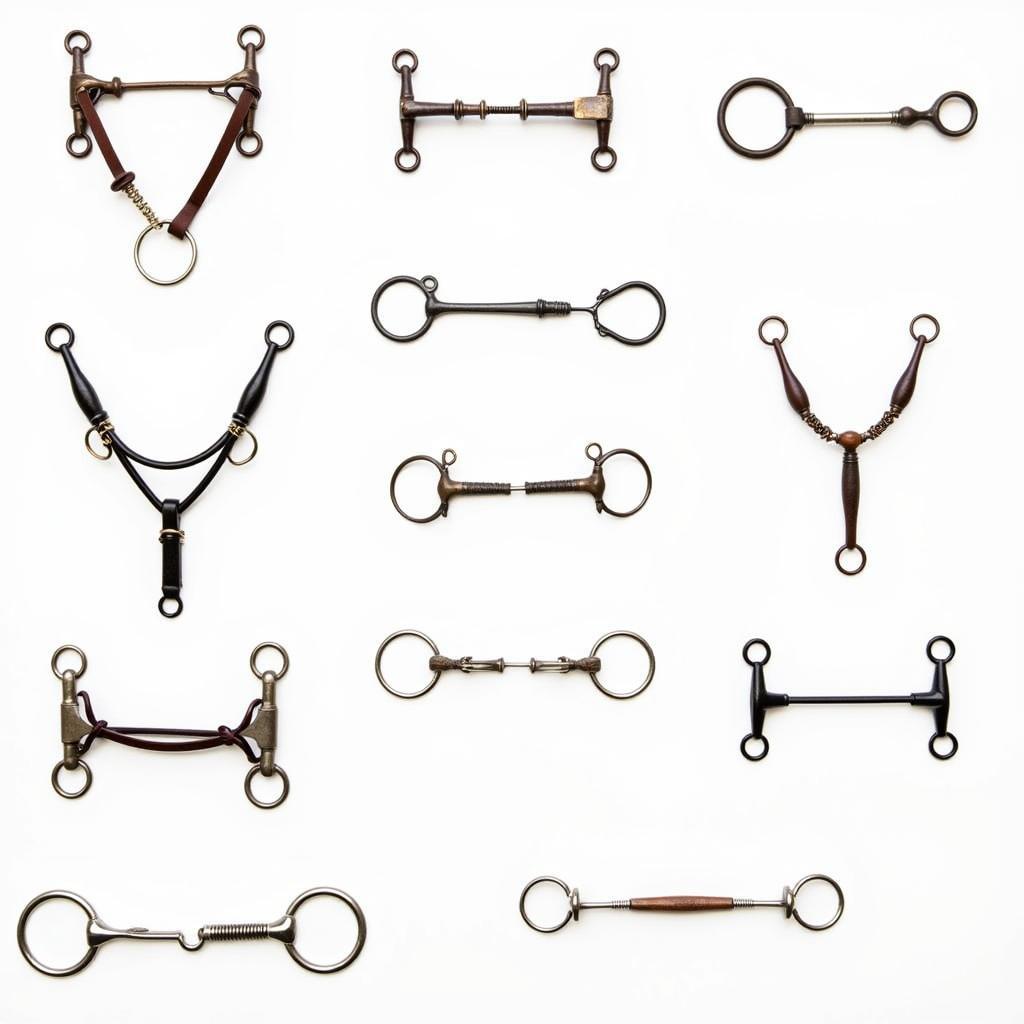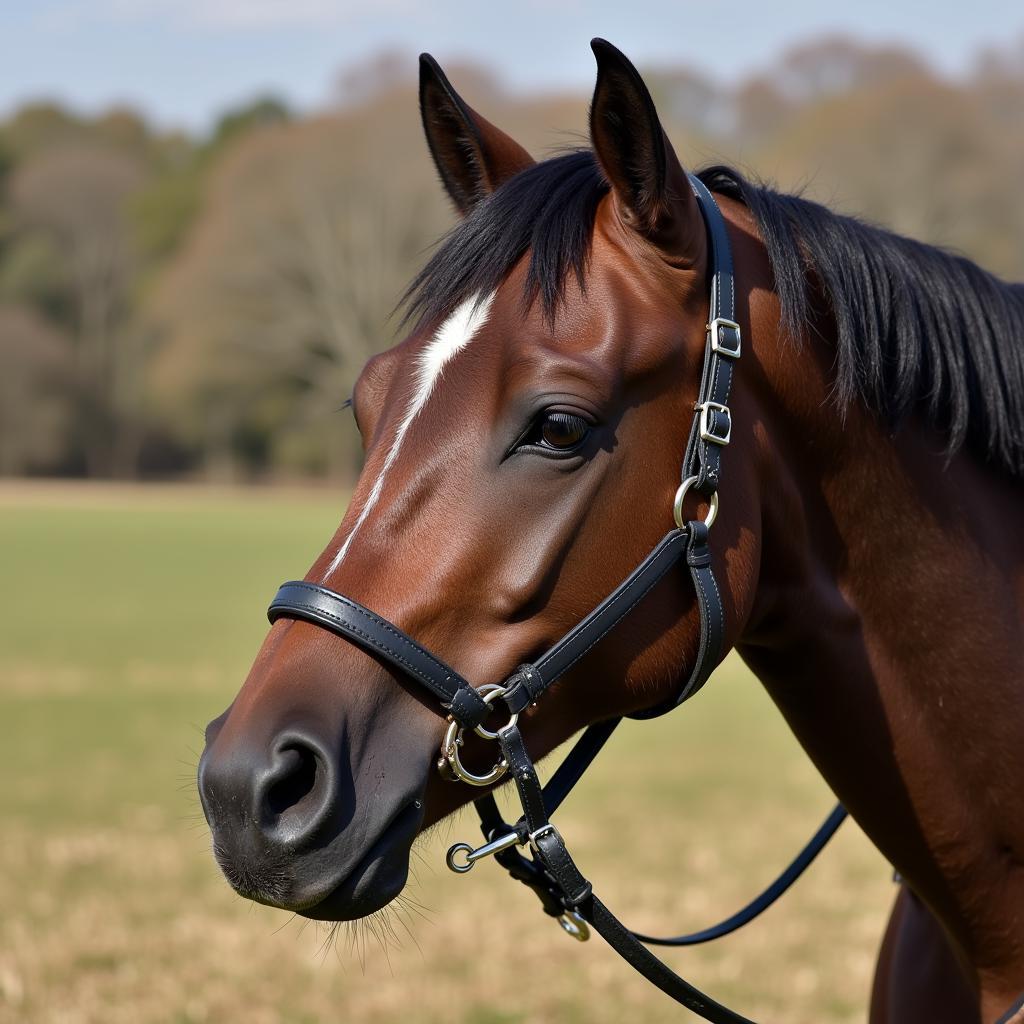A horse bit is more than just a piece of metal; it’s a crucial communication tool between you and your equine partner. Choosing the right bit for your horse is a critical decision that can significantly impact their comfort, performance, and overall well-being. With countless types and variations available, understanding the factors involved in selecting a bit can seem like a daunting task. This guide will equip you with the knowledge to make informed choices and find the perfect bit to enhance your horse’s communication and performance.
 Types of Horse Bits
Types of Horse Bits
Understanding Horse Bits: Key Considerations
Before delving into the specifics of different bit types, let’s establish a foundational understanding of the factors that influence bit selection.
1. Horse’s Mouth Conformation
Every horse has a unique mouth structure, much like humans. Some horses have fleshy, sensitive bars, while others have a higher palate or a smaller mouth. Examining your horse’s mouth will give you insights into the mouthpiece size, thickness, and shape that would suit them best.
2. Riding Discipline and Training Level
The type of riding you do directly influences the ideal bit choice. For instance, a snaffle bit might be appropriate for a horse starting their training in basic flatwork, while a curb bit might be more suitable for advanced maneuvers in Western riding disciplines.
 Horse with a Snaffle Bit
Horse with a Snaffle Bit
3. Horse’s Temperament and Sensitivity
Horses, like people, have individual personalities. A sensitive horse might react adversely to a harsh bit, while a less responsive horse might require a bit with more leverage for clear communication. Observing your horse’s reactions to different cues and pressures will help you gauge their sensitivity level.
4. Rider’s Experience and Skill Level
The rider’s experience also plays a role in bit selection. An experienced rider with soft hands can ride effectively in a wider variety of bits, while a less experienced rider might be better suited to a milder bit that is more forgiving.
Exploring Different Types of Bits for Horses
Now that you have a good grasp of the general considerations, let’s explore some common types of bits:
1. Snaffle Bits
Snaffle bits are known for their direct action and are often the first bit used in a horse’s training. They work on direct pressure, meaning the pressure is applied directly where the bit contacts the horse’s mouth.
Types of Snaffle Bits:
- Eggbutt Snaffle: This bit features an egg-shaped ring on the mouthpiece, preventing it from being pulled through the horse’s mouth.
- Loose Ring Snaffle: The rings on this bit rotate freely, encouraging the horse to relax their jaw and accept the bit.
- D-Ring Snaffle: The D-shaped rings on this bit offer slightly more lateral stability compared to loose rings.
For more information on snaffle bits, check out our detailed guide on elevator bits for horses.
2. Curb Bits
Curb bits, commonly used in Western riding, employ leverage to communicate with the horse. They apply pressure to the poll, chin groove, and bars of the mouth. Curb bits are generally used on more advanced horses who understand and respond to lighter cues.
Types of Curb Bits:
- Tom Thumb Bit: A popular choice for its versatility, the Tom Thumb bit features a short shank and a slight port in the mouthpiece. You can find more information about this bit in our article about the [tom thumb bit horse](https://justushorses.com/tom thumb-bit-horse/).
- Grazing Bit: Designed with longer shanks, the grazing bit allows for more leverage and is often used in disciplines where collection and control are paramount.
If you’re interested in learning more about Western bits, be sure to read our comprehensive guide on western horse bits explained.
 Horse with a Curb Bit
Horse with a Curb Bit
Finding the Perfect Fit: Bitting Your Horse Correctly
Once you’ve selected a bit, ensuring the correct fit is crucial.
- Bit Height: The bit should rest comfortably in the horse’s mouth, creating two wrinkles at the corners.
- Bit Width: The bit should be wide enough to prevent pinching but not so wide that it slides excessively.
Seeking Expert Advice
Remember, choosing the right bit is a process that often involves trial and error. Consulting with an experienced equine professional, such as a veterinarian or a reputable trainer, is invaluable. They can assess your horse’s individual needs and guide you towards the most suitable bit.
Conclusion: A Bit for Every Horse
Choosing the right Bit For A Horse is a multifaceted decision that should be made with careful consideration of the horse’s physical attributes, temperament, and the rider’s skill level. Remember, a bit is a communication tool, and selecting the right one can foster a harmonious partnership between horse and rider.
FAQs
1. Can I use the same bit for all riding disciplines?
While some bits offer versatility, it’s generally recommended to use bits specific to the demands of each riding discipline.
2. How often should I check the fit of my horse’s bit?
It’s good practice to check the fit of your horse’s bit regularly, especially if you notice any changes in their behavior or responsiveness.
3. What are mouthing bits used for?
Mouthing bits for horses are designed to help young or inexperienced horses get accustomed to the feeling of a bit in their mouths.
4. Where can I find used horse bits for sale?
You can often find used horse bits for sale at tack shops, online marketplaces, or through private sellers. However, be sure to inspect any used bit carefully for signs of wear and tear.
5. What should I do if my horse resists the bit?
Bit resistance can stem from various factors, including discomfort, improper fit, or training issues. Consult with a qualified equine professional to address the root of the problem.
Need More Help?
Choosing the right bit for your horse is a crucial step in ensuring their comfort and performance. For personalized guidance and expert advice, don’t hesitate to reach out to Justus Horses USA. Contact us at 0772127271 or [email protected], or visit us at QGM2+WX2, Vị Trung, Vị Thuỷ, Hậu Giang, Việt Nam. Our team of equestrian experts is available 24/7 to assist you.